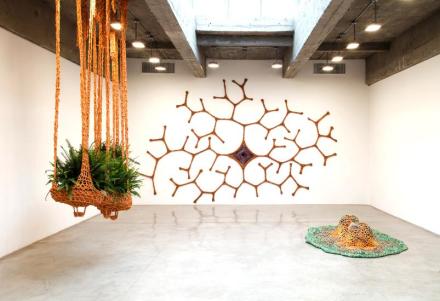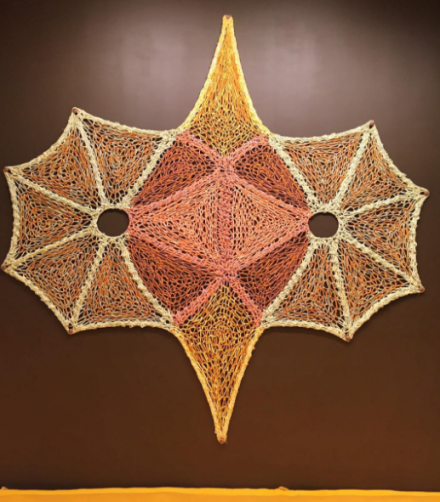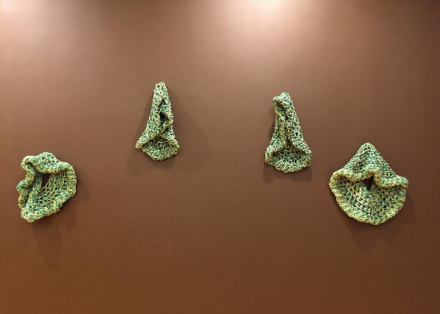
Ernesto Neto, The Serpent’s Energy Gave Birth To Humanity (Installation View), via Art Observed
Filling the main exhibition space at Tanya Bonakdar Gallery with another of his signature, finger-crocheted structures, artist Ernesto Neto has opened a new show in New York, reprising past works with this material and technique applied towards varied explorations of the spiritual, sexual, and communal in a single architectural space.  The show, which uses the Old Testament myth of temptation and expulsion from the Garden of Eden, to extend and explore the space of the human body as metaphor for both the tale’s moral implications, and contemporary explorations of social space.

Ernesto Neto, The Serpent’s Energy Gave Birth To Humanity (Installation View), via Tanya Bonakdar
Suspended by an intricate network of counterweights, Neto’s yurt structure and connected pathways is installed as a meditation on both the human body and the creation myths that often abstract or mythologize its form.  It’s hard to ignore the similarity of the work to the female reproductive system, with a large entrance slit giving way to could be interpreted as a pair of fallopian tubes.  Rounding the space, one is ultimately deposited in the center of the work, a knit hut where a single tree-trunk emerges from the center.  It’s dual role, both as visual anchor and symbolic reference to the Tree of Knowledge, ultimately returns the Biblical creation story to the body itself.  The tree, the fruit, and its varied images of the life process, sits within the womb, rather than outside, and its welcoming circle as a site of music and gathering, ultimately underscores a concept of shared humanity.
Ernesto Neto, The Serpent’s Energy Gave Birth To Humanity (Installation View), via Art Observed

Ernesto Neto, The Serpent’s Energy Gave Birth To Humanity (Installation View), via Art Observed
Yet the site is equally engaged with the processes of reproduction more broadly.  The pathway into the site bears striking resemblance to swimming spermatozoa, rushing in to fertilize a waiting egg, and the frequent allusions to the temptations of man and woman manage to keep the space from wandering too close to a role as a simplistic adult play-land.  Passing through the netting of the tunnels in the space, or sitting within main room,  one is constantly reminded of the human body and its functions.

Ernesto Neto, The Serpent’s Energy Gave Birth To Humanity (Installation View), via Tanya Bonakdar

Ernesto Neto, The Serpent’s Energy Gave Birth To Humanity (Installation View), via Art Observed
Given the prominent sexual iconography of the space, Neto manages to work in these slow, subtly unfolding threads of perspective into the modern human condition.  The space itself, for all of its weighty imagery, is particularly welcoming, and leaves visitors wandering wide-eyed through its space for long stretches of time before resting for even longer inside the yurt.  What results is a sense of the feminine as a site not merely of mothering and nurturing, but as a site of the social, of the womb as a social construct where both spiritual unity and socialization can develop and flourish.  Watching visitors meet and socialize in this room, one can watch human behavior functioning within a framework of its own abstraction, human identity shaped within a structure built from its oldest modes of understanding and conceptualizing the world around us.  Rather than fall into rehashed imaginations of the same myth, Neto’s conception of human creation is one that circles endlessly, a mode of understanding our origins by looking deeper into the fundamental nature, and physiological processes, of the body itself.
The Serpent’s Energy Gave Birth To Humanity closes on December 17th.

Ernesto Neto, The Serpent’s Energy Gave Birth To Humanity (Installation View), via Art Observed
— D. Creahan
Read more:
Ernesto Neto:The Serpent’s Energy Gave Birth To Humanity [Exhibition Site]




